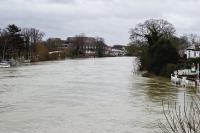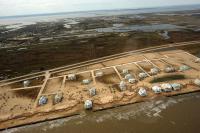-
Climate change likely to increase frequency, magnitude of severe U.K. flooding events

Last December, following severe flooding across parts of Northern England and Scotland and on the eve of the climate summit in Paris – which was held 30 November – 12 December 2015 — Lord Deben, chairman of the U.. Committee on Climate Change, said: “Defenses that might historically have provided protection against a 1 in 100 year flood will, with climate change, provide a much lower level of protection and be overtopped more frequently. The latest projections suggest periods of intense rainfall could increase in frequency by a factor of five this century as global temperatures rise.”
-
-
U.S. experiences 5th warmest summer on record

An oppressively hot Summer 2016 for many across the contiguous United States tied 2006 as the 5th warmest in 122 years of record keeping. The average summer U.S. temperature was 73.5 degrees F, 2.1 degrees above average, according to scientists from NOAA. . Every state in the continental United States and Alaska were warmer than average this summer – with lower 48 also having 3rd warmest year to date and second wettest August. Precipitation totaled 0.60 inch above average, making summer the 24th wettest on record.
-
-
Human activity has been causing climate change for nearly two centuries
An international research project has found human activity has been causing global warming for almost two centuries, proving human-induced climate change is not just a twentieth century phenomenon. The study found warming began during the early stages of the Industrial Revolution and is first detectable in the Arctic and tropical oceans around the 1830s, much earlier than scientists had expected.
-
-
Solar-powered Ring Garden combines desalination, agriculture for drought-stricken California
With roughly 80 percent of California’s already-scarce water supply going to agriculture, it is crucial for the state to embrace new technologies that shrink the amount of water required to grow food. Alexandru Predonu has designed an elegant solution which uses solar energy to power a rotating desalination plant and farm that not only produces clean drinking water for the city of Santa Monica, but also food crops — including algae.
-
-
Data shows growing political polarization on climate change
New research discusses the increasing partisan polarization of American attitudes toward climate change. The article details the escalation of partisan polarization, particularly toward environmental protection and climate change, over the past few decades in America, showing an increasing gap between self-identified Republicans’ and Democrats’ attitudes toward human-caused climate change. While Democrats have increasingly accepted the reality and seriousness of climate change over the past two decades, Republicans have become more skeptical.
-
-
Chicago becomes first city to launch Array of Things, an innovative urban sensing project
This week in Chicago, the Array of Things team begins the first phase of the groundbreaking urban sensing project, installing the first of an eventual 500 nodes on city streets. By measuring data on air quality, climate, traffic, and other urban features, these pilot nodes kick off an innovative partnership among different organizations aiming better to understand, serve, and improve cities.
-
-
Assessing climate change vulnerability in urban America
Impacts of climate change – rising sea levels, heat waves, rising rates of diseases caused by ticks, fleas, and mosquitoes, and many more — will affect cities across the country. One of the first efforts systematically to assess how cities are preparing for climate change shows that city planners have yet fully to assess their vulnerability to climate change, leaving serious risks unaddressed. Most city planners have yet to prepare for climate-related risks and the consequences.
-
-
Pace of Earth’s warming “unprecedented in 1,000 years”: NASA
The warming of the planet is proceeding at a pace not experienced within the past 1,000 years, making it “very unlikely” to keep warming to 1.5 degrees Celsius – the goal agreed by nations at the Paris climate summit last December. Recent research found that continuing current levels of carbon dioxide emissions for just five more years will eliminate any chance of restraining temperatures to a 1.5C increase and avoid runaway climate change.
-
-
Rising seas threaten 1.9 million U.S. homes with current value of $882 billion

Typically when we talk about “underwater” homes, we are referring to negative equity. But there is a more literal way a home can be underwater: Rising sea levels, and the flooding likely to come with them, could inundate millions of U.S. homes worth hundreds of billions of dollars. If sea levels rise as much as climate scientists predict by the year 2100, almost 300 U.S. cities would lose at least half their homes, and 36 U.S. cities would be completely lost. The total combined current value of all homes at risk of being underwater with a 6-feet rise in sea levels is $882 billion.
-
-
Global warming would make most cities too hot, humid to host summer Olympics
The future of the summer Olympics may be in jeopardy because of rising heat and humidity due to climate change. By 2085, only eight Northern Hemisphere cities outside of Western Europe are likely to be cool enough to host the summer games. The authors considered only cities with at least 600,000 residents, the size considered necessary for hosting the games. Cities with elevations over a mile above sea level were omitted as such an altitude (for example, Mexico City in 1968) faced challenges of their own.
-
-
Economic growth will not counterbalance increasing climate change-related damage
More than 50 percent of all weather-related economic losses on the globe are caused by damages due to tropical cyclones. New research finds that financial losses per hurricane could triple by the end of the century in unmitigated climate change, while annual losses could on average rise by a factor of eight. The researchers also concluded that economic growth will not be able to counterbalance the increase in damage.
-
-
How a new source of water is helping reduce conflict in the Middle East
Just a few years ago, in the depths of its worst drought in at least 900 years, Israel was running out of water. Now it has a surplus. This remarkable turnaround was helped by increasing conservation and re-use – but the biggest impact came from a new wave of desalination plants. Israel now gets 55 percent of its domestic water from desalination. Moreover, scientists and others look to desalination as a way to unite longtime enemies in a common cause.
-
-
July 2016 was the warmest month since modern record-keeping began in 1880
July 2016 was the warmest July in 136 years of modern record-keeping, which began in 1880. The record warm July continued a streak of ten consecutive months dating back to October 2015 that have set new monthly high-temperature records.
-
-
Climate change to increase health risks from wildfires in U.S. West
A surge in major wildfire events in the western United States as a consequence of climate change will expose tens of millions of Americans to high levels of air pollution in the coming decades. The researchers estimated air pollution from past and projected future wildfires in 561 western counties, and found that by mid-century more than eighty-two million people will experience “smoke waves,” or consecutive days with high air pollution related to fires.
-
-
Assessing crop damage after extreme weather
The Philippines is host to six to nine tropical cyclones per year since 1970, and a citizenry that consumes more rice than it produces. The Philippines has for many years augmented its homegrown supply of rice with imports based on seasonal climate forecasts and agricultural production surveys. But import orders must be modified on the fly when extreme weather events exact a heavier toll on production than expected. New method to track the impact of typhoons and other natural disasters could enable more precise, timely delivery of food aid.
-
- All
- Regional
- Water
- Biometrics
- Borders/Immig
- Business
- Cybersecurity
- Detection
- Disasters
- Government
- Infrastructure
- International
- Public health
- Public Safety
- Communication interoperabillity
- Emergency services
- Emergency medical services
- Fire
- First response
- IEDs
- Law Enforcement
- Law Enforcement Technology
- Military technology
- Nonlethal weapons
- Nuclear weapons
- Personal protection equipment
- Police
- Notification /alert systems
- Situational awareness
- Weapons systems
- Sci-Tech
- Sector Reports
- Surveillance
- Transportation
Advertising & Marketing: advertise@newswirepubs.com
Editorial: editor@newswirepubs.com
General: info@newswirepubs.com
2010-2011 © News Wire Publications, LLC News Wire Publications, LLC
220 Old Country Road | Suite 200 | Mineola | New York | 11501
Permissions and Policies
Editorial: editor@newswirepubs.com
General: info@newswirepubs.com
2010-2011 © News Wire Publications, LLC News Wire Publications, LLC
220 Old Country Road | Suite 200 | Mineola | New York | 11501
Permissions and Policies
